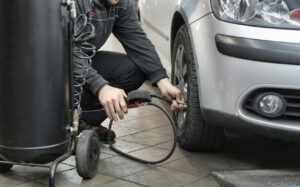Driving in extreme weather conditions can be challenging and dangerous. Whether it’s heavy rain, snow, ice, fog, or high winds, each type of extreme weather requires specific strategies to ensure safety on the road. This guide will provide you with practical tips and techniques to navigate through adverse weather conditions safely.
1. Preparation is Key
Before you even get behind the wheel, preparation is essential to ensure your safety during extreme weather conditions.
Vehicle Maintenance
- Tires: Ensure your tires have adequate tread depth and are properly inflated. Consider using winter tires in snowy and icy conditions.
- Brakes: Check that your brakes are in good working condition.
- Battery: Make sure your battery is fully charged and in good condition.
- Fluids: Keep all fluids, including oil, coolant, and windshield washer fluid, topped off.
- Wipers: Replace worn wiper blades to ensure clear visibility.
Emergency Kit
- Essentials: Carry an emergency kit that includes items such as a first-aid kit, flashlight, blanket, food and water, ice scraper, and a phone charger.
- Tools: Include basic tools like a jack, lug wrench, and jumper cables.
2. Driving in Heavy Rain
Heavy rain can significantly reduce visibility and traction, increasing the risk of hydroplaning. Here’s how to drive safely in wet conditions:
Reduce Speed
- Slower Pace: Drive at a slower pace to maintain better control of your vehicle and increase your reaction time.
Increase Following Distance
- Safe Distance: Maintain a greater distance between your car and the vehicle in front of you to allow for longer stopping distances.
Use Headlights
- Visibility: Turn on your headlights to improve visibility for yourself and others. Avoid using high beams, as they can reflect off the rain and reduce visibility.
Avoid Standing Water
- Hydroplaning Risk: Avoid driving through standing water to reduce the risk of hydroplaning. If you do hydroplane, ease off the accelerator and steer in the direction you want to go.
3. Driving in Snow and Ice
Snow and ice present unique challenges, including reduced traction and visibility. Here are some tips for driving in winter conditions:
Slow Down
- Cautious Driving: Drive slowly and smoothly to maintain control and avoid sudden movements that can lead to skidding.
Use Snow Tires
- Better Traction: Snow tires provide better traction and control in icy and snowy conditions.
Brake Gently
- Avoid Skidding: Apply brakes gently to avoid skidding. If your car has anti-lock brakes (ABS), apply steady pressure to the brake pedal.
Steer Smoothly
- Avoid Sudden Moves: Make gentle, smooth steering movements to avoid losing control.
Clear Snow and Ice
- Visibility and Safety: Clear snow and ice from all windows, mirrors, lights, and the roof of your car to ensure maximum visibility and prevent snow from flying off and hitting other vehicles.
4. Driving in Fog
Fog can significantly reduce visibility, making it difficult to see other vehicles and road signs. Here’s how to drive safely in foggy conditions:
Use Low Beams and Fog Lights
- Visibility: Use low beams or fog lights to improve visibility without creating glare. Avoid using high beams, which can reflect off the fog and reduce visibility.
Reduce Speed
- Slow Down: Drive at a slower pace to give yourself more time to react to obstacles and other vehicles.
Increase Following Distance
- Safe Distance: Maintain a greater distance from the vehicle in front of you to allow for longer stopping distances.
Use Road Markings
- Guidance: Use the road markings to guide you. Follow the lines to stay in your lane and maintain a safe path.
Avoid Stopping on the Road
- Safety: If you must stop, pull off the road as far as possible and use your hazard lights to alert other drivers.
5. Driving in High Winds
High winds can make it difficult to control your vehicle, especially on open roads or bridges. Here’s how to handle driving in windy conditions:
Reduce Speed
- Control: Drive at a slower pace to maintain better control of your vehicle.
Keep Both Hands on the Wheel
- Stability: Keep a firm grip on the steering wheel to counteract sudden gusts of wind.
Avoid Large Vehicles
- Stay Clear: Stay clear of large vehicles like trucks and buses, which can be more affected by wind and may sway or drift into your lane.
Be Aware of Debris
- Watch for Hazards: Be alert for debris on the road, such as branches or trash, which can be blown into your path.
6. Driving in Extreme Heat
Extreme heat can affect your vehicle’s performance and increase the risk of breakdowns. Here’s how to drive safely in hot weather:
Check Coolant Levels
- Prevent Overheating: Ensure your coolant levels are adequate to prevent your engine from overheating.
Monitor Tire Pressure
- Avoid Blowouts: Check your tire pressure regularly, as high temperatures can cause tires to overinflate.
Stay Hydrated
- Health: Keep water in your car to stay hydrated, especially on long trips.
Avoid Overloading
- Reduce Strain: Avoid overloading your vehicle to reduce strain on the engine and tires.
7. General Tips for All Weather Conditions
Stay Informed
- Weather Updates: Check weather forecasts and road conditions before you set out on a trip. Use apps and websites to stay updated on real-time conditions.
Plan Your Route
- Safe Travel: Plan your route to avoid areas known for severe weather. Consider alternative routes that may be safer.
Use Technology
- Safety Features: Utilize your vehicle’s safety features, such as traction control, stability control, and all-wheel drive, if available.
Stay Calm
- Avoid Panic: Stay calm and composed in extreme weather conditions. Panic can lead to poor decisions and increase the risk of accidents.
Driving in extreme weather conditions requires preparation, caution, and the right techniques to ensure your safety and the safety of others on the road. By following these tips and staying informed about weather conditions, you can navigate through rain, snow, fog, high winds, and extreme heat with confidence. Remember, safety should always be your top priority. If conditions become too dangerous, it’s best to wait until the weather improves before continuing your journey. Stay safe and drive carefully!



